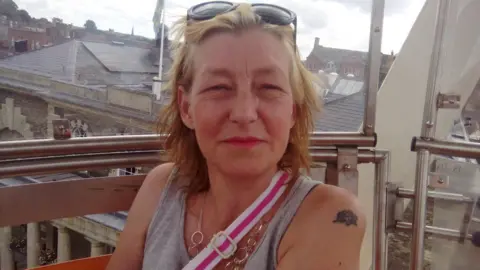'Many lethal doses' of Novichok used in poisonings
 Rex Features
Rex FeaturesThe lead scientific adviser who advised police after the poisoning of a former Russian spy said it is highly likely "many lethal doses" of nerve agent Novichok were used.
Speaking at the Dawn Sturgess Inquiry in London, the Defence and Science Technology Laboratory (DSTL) witness, referred to only as MK26, said a sample the size of "a third of, to a sixth, of a grain of salt" could have been a fatal human dose.
Ex-Russian spy Sergei Skripal, his daughter Yulia and then police officer Nick Bailey were all poisoned by Novichok in Salisbury in March 2018. All survived.
However, Ms Sturgess, 44, died in July 2018 after being exposed to the nerve agent.
 Reuters
ReutersMs Sturgess, a mother of three from Wiltshire, became contaminated via a discarded perfume bottle in nearby Amesbury.
At the inquiry, MK26 was asked if the bottle of Novichok that killed Ms Sturgess was the same one used in the Salisbury attack months before, where it was left on the door handle of the Skripals' home.
They said: "I think I have tried to express my uncertainty because it's unclear exactly what the circumstances were of finding that bottle and the assembly of that bottle and so without that information, it's not possible to exclude that there were two bottles."
Counsel to the inquiry, Andrew O’Connor, asked if it was possible that a different bottle - "one that has not been found" - was used in the Salisbury attack.
"And the bottle that we did then find... was a bottle that had been brought along and was discarded without having been used in Salisbury?”
MK26 replied: “I think that’s possible.”
MK26, who has worked as a research scientist for 20 years and is based at the DSTL in Porton Down, near Salisbury, said very few people would have been capable of safely producing the nerve agent because of how "highly hazardous" it is, even in small quantities.
They added the competence of those working with the substance would need to be "extremely advanced".
Samples of the nerve agent were taken from Mr Skripal's door handle 12 days after the poisonings.
Rainwater and snow potentially affected its concentration levels, the inquiry heard.
MK26 told the inquiry: "After many days of weathering, with the contamination found throughout the locations visited in Salisbury that afternoon by the Skripals, suggests that it is highly likely that there were many lethal doses of the highly toxic specific Novichok applied to the door handle."
MK26 added the nerve agent had a concentration level of 97-98%.
They said the operations room in Porton Down was "running 24/7" in the wake of the poisonings.
"I haven't seen this level of activity any time before that or since and I hope I never do again."
They said the incident felt "very personal" and left an impact on the staff, due to its proximity to where many of them lived.
"When Dawn Sturgess sadly passed away, it highlighted to us how dreadful it had been and we were all really sorry that that happened," MK26 added.
 Facebook
FacebookMK26 told the inquiry the use of chemical weapons was "very rare" and they had never seen the use or appearance of Novichok until the events of 2018.
They said the poisoning of late Russian opposition leader Alexei Navalny in 2020 was the only other instance in which the nerve agent had been used, as far as they were aware.
"There is no reason for these chemicals to be present anywhere other than that they have been made deliberately to cause harm," MK26 said.
“It was clear that whichever laboratory had made this had not only made it but synthesised it, which adds a layer of complexity, a layer of sophistication and a layer of hazard to the operators who are undertaking that procedure.”
The inquiry continues.

BBC Sounds: Salisbury Poisonings
Keep up to date with the latest from the inquiry with our podcast.
Listen to the episode on BBC Sounds.

Follow BBC Wiltshire on Facebook, X and Instagram. Send your story ideas to us on email or via WhatsApp on 0800 313 4630.
